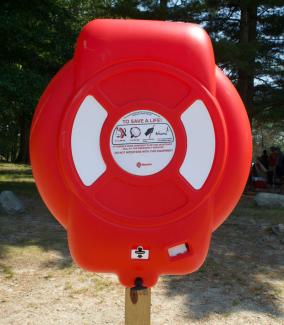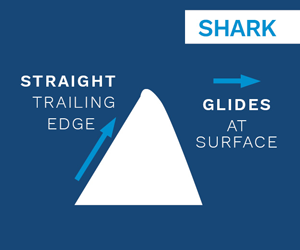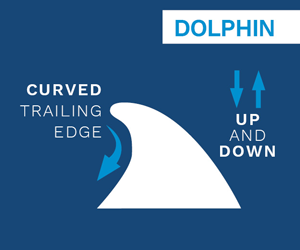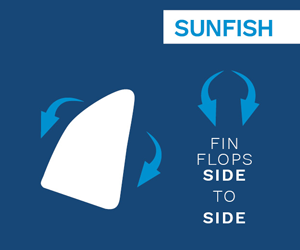Beach Safety
Jump to:
Life Rings
Life rings provide flotation to a person struggling in the water and at risk of drowning until emergency personnel arrive. Thanks to the Water Safety Grant Program, DEM has installed 12 life rings across Rhode Island:
- Burlingame State Park Picnic Area, Charlestown
- Burlingame State Campground, Charlestown
- Charlestown Breachway State Beach & Campground, Charlestown
- East Matunuck State Beach, South Kingstown
- George Washington Campground, Glocester
- Goddard Memorial State Park Beach, Warwick
- Lincoln Woods State Park Olney Pond, Lincoln
- Misquamicut State Beach, Westerly
- Pulaski State Park, Glocester
- Salty Brine State Beach, Narragansett
- Scarborough North State Beach, Narragansett
- Scarborough South State Beach, Narragansett

BEACH WARNING FLAGS
Rhode Island DEM’s Division of Parks and Recreation uses a colored flag system to denote ocean conditions each day at state beaches. The eight Rhode Island State Beaches are Charlestown Breachway, East Beach in Charlestown, East Matunuck in South Kingstown, Misquamicut in Westerly, Roger Wheeler, Scarborough North and Scarborough South, and Salty Brine in Narragansett.
During the beach season, remember to swim only in designated swimming areas, near lifeguards and listen to safety announcements.





RIP CURRENTS
Rip currents can be extremely dangerous to even the strongest swimmers. If caught in a rip current, don't fight it! Swim parallel to the shore and swim back to land at an angle. If you can’t swim out of the current, float or tread water while waving and yelling for help. It's always a good idea to check-in with lifeguards and listen for announcements on beach and ocean conditions so you can stay away from surf hazards. Find more tips and resources for "breaking the grip of the rip" here.
HIGH SURF ALERTS
Rhode Island often experiences needless tragedy during storms when wave-watchers or anglers who have climbed onto rocks near the shore get hit by waves, are quickly swept out to deep water, and drown. Along with some anglers, "storm watchers" put themselves in danger by standing too close to the surf on rocks along the shoreline in fishing areas, breakwalls, and breachways. Stay safe by remaining far away from areas where waves might splash over. Waves possess enormous force and can easily sweep a person into the water from what seems to be a safe viewing area. Get the latest surf forcast here.
FIN SIGHTINGS
Rhode Island Department of Environmental Management (DEM) has developed guidelines for fin-sightings that occur at Rhode Island’s eight state beaches. When a fin is sighted in the waters off a state beach, RI State Parks staff will evacuate swimmers from the water. The protocol calls for swimmers to remain out of the water for an hour after an actual or suspected shark sighting, while DEM marine biologists and environmental police investigate the sighting. We take our responsibility to protect the health and safety of visitors to state beaches very seriously and it requires a high level of cooperation between DEM staff and divisions.
The waters off Rhode Island are part of a natural ecosystem that contains some risk for people. In the ocean, this includes interacting with sharks. Sharks help maintain the balance of ocean ecosystems as a large marine predator. At any given time, we know that blue sharks, mako sharks, sand tiger sharks, thresher sharks, and great whites are present in our waters along with a wide diversity of other marine species. It is impossible to eliminate risk, but here’s how to minimize interactions with sharks and reduce overall risk.
SHARK SAFETY TIPS:
-
Stay out of the ocean at dusk, night, and dawn
-
Avoid areas with schools of splashing fish or diving seabirds
-
Avoid murky water
-
Swim, paddle, and surf in groups
-
Avoid swimming in areas with seals
-
Swim where your feet can touch the bottom
-
Always follow instructions from lifeguards



DEM’s Division of Marine Fisheries works in collaboration with The Atlantic Shark Institute, the University of Rhode Island, and local charter boat captains to monitor and better understand the presence of sharks in our state waters.
A network of acoustic receivers are positioned on buoys throughout Rhode Island waters to detect fish that have been acoustically tagged. To date, the receivers have detected a variety of species, including sand tiger sharks, river herring, Atlantic sturgeon, and skates. By far the most common species detected from these receivers is striped bass, which several researchers from universities and government agencies have tagged over the last ten years.
The data collected from this initiative helps researchers better understand the timing of arrival and departure for seasonal species, identify areas of critical habitat or importance for taxa, and capture the presence of species that are not well detected in traditional fisheries surveys. It will also be used to support determinations of stock assessments, quota management, and public safety practices. Learn more at www.dem.ri.gov/marine.
Sharks of Rhode Island

Shortfin Mako
Very pointed snouts and long gill slits with dark blue/gray backs, light blue sides, and white undersides. Up to 13 feet in length.

Blue Shark
Long, pointed pectoral fins. Long, rounded snout with slender body. Dark blue above; bright blue sides; white underside. Up to 12.5 ft.

Sand Shark
Flat, conical snout. Adults have reddish-brown spots scattered, mostly on the hind part of the body. Up to 18 ft.

Thresher Shark
Blackish pectoral, pelvic, and dorsal fins. Sickle-shaped tail. Upper body is extremely long, about half the length of their body. Up to 20 ft.

White Shark
Conical snout with first dorsal fin large, triangular in shape. White to brown or black above, shading to gray-white below. Up to 21 feet.

Hammerhead Shark
Head broadly arched and hammer-shaped. Color is deep olive to brownish-gray above, shading to white below. Size up to about 13 ft.
